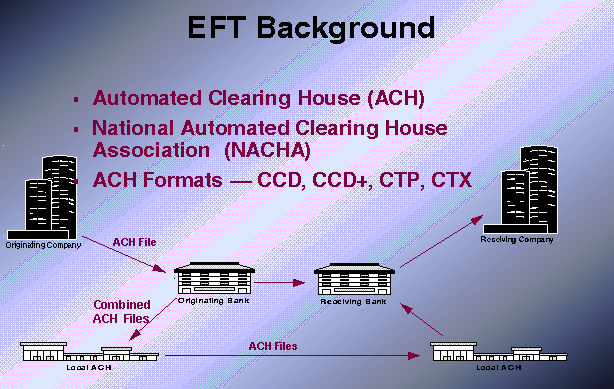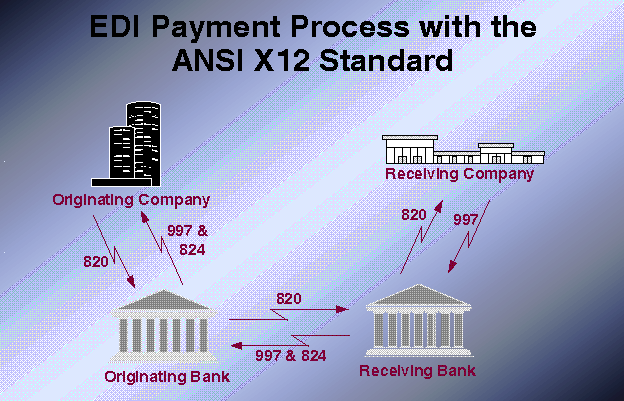Financial EDI and EFT
Author: Michael Kinahan
Purpose: 547 Project Report
 Back to Title Page
Back to Title Page
Introduction
Electronic Funds Transfer (EFT) is actually quite a generic term. The label EFT
encompasses any monetary transaction that is completed by electronic means; i.e.
Automated Teller Machine (ATM) transactions, wire transfers, point of sale (POS)
transactions, and tape exchange
of financial data. This report however, will focus on the coupling of EFT with
Electronic Data Interchange (EDI) technologies -- where EDI refers to computer-
to-computer electronic exchange of business documents such as purchase orders and
shipping notices between business partners, in a computer readable format.
Combining EDI and EFT
With the ever increasing number of businesses utilizing EDI technologies to communicate
with their suppliers and customers to conduct business -- invoices, orders, etc -- they
will not want their payment information to be paper based. It is therefor natural for these
companies to take the next step to incorporating EFT with EDI.
By combining EFT with the advantages provided by EDI (automatic processing
of business transactions without human intervention) businesses gain in many ways:
- Reduce time spent in data entry, paper processing and error correction, by having
your accounts payable system directly feed your EDI translator.
- Reduce/eliminate the costs associated with cheque preparation, enveloping,
mailing, cheque disbursement, cheque reconciliation, storage and retrieval by creating
and sending payments electronically to the bank.
- Accurate cash flow forecasting for these payments, and improve control of overall
cash flow because the transfer of funds are guaranteed on value date. This also allows
you to take advantage of discounts by establishing set payment dates.
- No time is due to mail and processing float, as payment can be sent from anywhere.
- Reduce time, errors, and cost of handling incoming cheques, bank deposits and
data entry into your accounts receivable system.
The role of banks in EDI
When it comes right down to it, banks are the only organizations that can process any sort of
money transaction. If two companies wish to enter into an EDI partnership, they may directly
transfer all ordering and invoice information directly between each other, but any transfer of
funds must be made via an electronic request to a bank. Upon receipt of this request, the
bank may either transfer the funds directly (if both companies use the same bank) or go through
appropriate channels to settle with another bank (see sections on banking in Canada
or the U.S.)
 EFT in the U.S.A.
EFT in the U.S.A.
The Automated Clearing House (ACH)
The ACH was developed as a computer-based alternative to the paper-
based check-clearing process. Under paper-based systems, checks are sorted by financial
institutions, and bundles of paper checks are exchanged among the various banks. Under ACH,
electronic images of the checks are sorted and then the electronic records are exchanged.
The electronic transfer can be completed by network connections or by physical transfer
of magnetic tapes of floppy disks. The format of the information, and the handling and processing
of the data is defined by the National Automated Clearing House Association (NACHA).
 Some important dates in the development of ACH:
Some important dates in the development of ACH:
- Late 1960's: The San Francisco and Los Angeles Clearing House Associations created a
joint committee to investigate paperless exchange.
- 1970: The first software for paperless exchange was developed by a committee consisting
of ten California banks.
- 1972: The Federal Reserve Bank of San Francisco and the Los Angeles Branch began to
offer the first automated, electronic, clearing house services.
- 1974: The NACHA was formed to develop national standards and policy for electronic
payments.
- 1975: The federal government began to use ACHs for direct deposit of Social Security
payments.
- 1978: The Federal Reserve established electronic exchange between regions, thus establishing
a nationwide autometed clearing house system (Managed by the NACHA and the Federal Reserve).
ACH Formats
Cash Concentration or Disbursement (CCD): From 1974 until 1983, CCD was the only
format provided by the ACH system. This format only permits single payment transactions, with
minimal room for advice information (94 total characters with 34 available for advice). There
was also no standard for the advice information, therefore it could not be automatically processed.
These limitations of the CCD format were major reasons why it was not used extensively for
corporate trade.
Cash Concentration or Disbursement plus Addendum (CCD+): This is simply the CCD
format with an extra 80-character addendum added for more advice information.
Corporate Trade Payment (CTP): This format allows for much more advice information
(up to 4999 messages of 94 characters each). Thus, the payee could receive the same information
normally included in a paper-based payment advice. Unfortuanately, this format still doesn't
provide a standard for the advice information, therefore the information can't be automatically
processes.
Corporate Trade Exchange (CTX): This format is a variable length format that supports
the ANSI X12 standard for remittance advice. The CTX format provides an electronic envelope
for the ANSI X12 820 Payment Order/Remittance Advice, therefore the advice information can
be automatically processed through their EDI systems. This format makes the ACH an appropriate
alternative to checks for corporate trade payments.
The Canadian Payments Association
The CPA-005 is an electronic enveloping structure that is designed and maintained by the
Canadian Payments Association (CPA). The CPA is a quasi-governmental body, enacted
by the Canadian Parliament, whose role is to "manage the evolution of the payments system
in Canada".
Historically, Canada has conducted EFT transaction among banks using the CPA-005 format,
which is similar to the CCD format. A typical CPA-005 EFT transaction
flows as follows:
- The payment record is created in the CPA-005 format by the initiating company. This will
include such information as destination, bank and account number, name, amount, value date, and
a brief description.
- The information is then forwarded to the company's bank (usually physical transfer of magnetic
tape). This is usually done two to four days prior to the value date, to ensure that all end points
equal value dating. During this time, the payor bank may assume the risk for up to four days
(the payor bank my have sent the promise to pay to another bank prior to the value date, during
which time, the payor's account may become deficient of funds).
- On value date, all credits are posted and settlement occurs. No responses or confirmations
are received. The receiving client is updated either through a cash management inquiry or via
printed statement of account.
EDI banking in Canada
In 1989, Canada's six larges banks met to discuss the implications of EDI and how the banks
might take advantage of it. The result was a revolutionary concept to design a new corporate payment
mechanism that is not limited to simply extending the current EFT process.
The Canadian Inter-Financial EDI Committee (Inter*EDI) was formed to review international EDI
successes or examples to use as a guide for the development of financial EDI in Canada. Unfortunately,
no other banks, or even non-bank service providers, had integrated such an approach into their
fabric. As a result, Inter*EDI defined a unique series of guidelines that outline the blueprint for EDI
and EFT.
- Data-Driven: The funds transfer would be an act determined by examining the data
content of an EDI transaction. This makes the bank an active and meaningful part of the information
transfer process, not just a conduit.
- Credit-Driven: It was determined that EDI/EFT should result from an overt act
by the payor. Although there was some demand by the sellers for creating a debit access or
"demand" invoice, the liability and recourse implications of such an approach made it both unwise
and or substantial risk.
- Guaranteed Payment: As a direct result of the overt credit transfer process by the
originator, the EDI/EFT payment could be made irrevocable and guaranteed. By incorporating
both ANSI X12 Transaction Sets 997 (Functional Acknowledgment) and Transaction Set 824
(Application Acknowledgement) there is a clear statement by the receiving bank that it had
received the payment and would act on the instruction. This also supports the audit and control
process by creating a mechanism for tracing the transaction. (The NACHA rules for EFT in the
U.S. do not provide for such irrevocability of payments, which allows the element of risk to
enter the payment system in the event of failure of the originating bank.)
- ANSI X12 Standard: This was chosen because the vast majority of Canadian
trade is with the U.S., and X12 is the predominant standard used by business in North
America.
- Security: The primary tool for security is the Message Authentication Code (MAC),
utilizing the Data Encryption Standard (DES) algorithm. The MAC is like a check sum that
is calculated by the sender and passed through the DES algorithm; with the additional use of
an electronic key. The receiver then recalculates the value using the same keys and algorithm,
confirming the validity of the transaction. If the MAC received from the sender differed from
the MAC calculated by the receiver, an error is assumed. Further privacy can be achieved by
encrypting the data as well.
- Improved Lead Times: Although virtually all EDI applications operate in a batch, the
Canadian EDI/EFT mechanism is designed to be a quick, mini-batch process (near on-line or
near-time). This provides for same-day originating and receiving capability, sometimes even
within the same hour.
 Legend of ANSI X12 forms:
Legend of ANSI X12 forms:
820: Payment Instructions
Instructions from originating company to
bank, or from one bank to another, detailing payment instructions.
824: Application Acknowlegement
An acknowledge sent to initiating
company or bank indicating that the 820 form was processed without problem.
997: Functional Acknowlegement
An acknoledgement sent to initiating
company or bank indicating initial receipt of the 820 form.
Links to other sections of this report:
![]() Some important dates in the development of ACH:
Some important dates in the development of ACH: